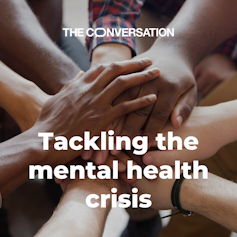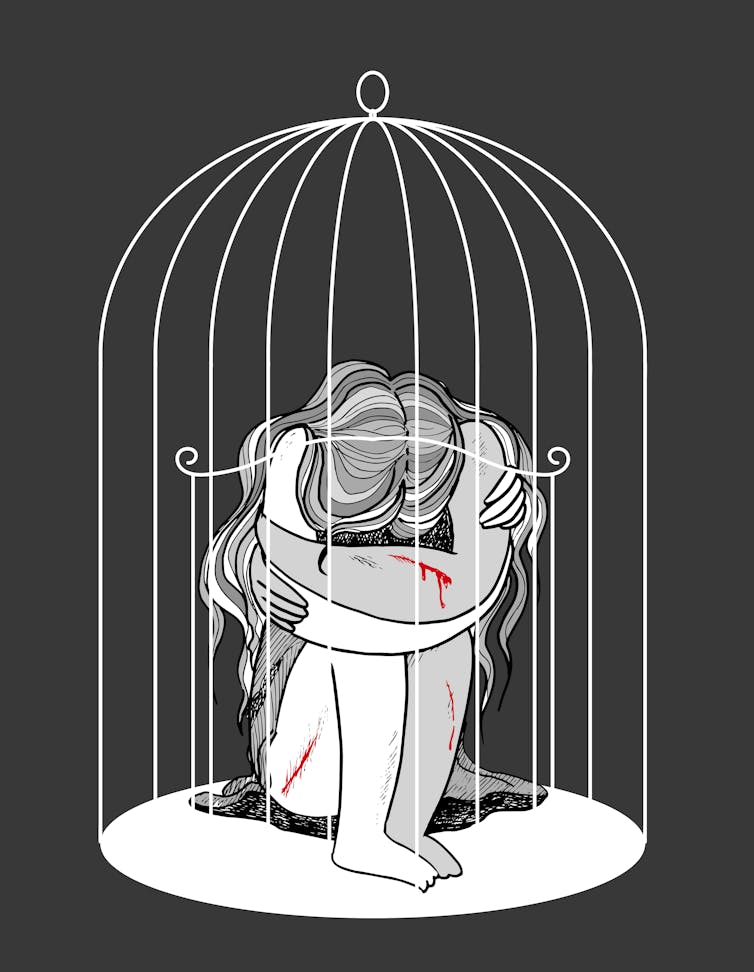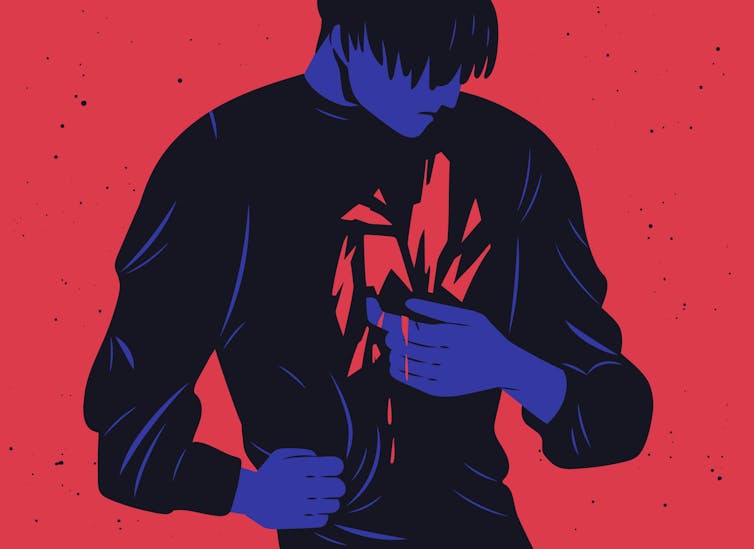This article discusses self-inflicted injury and mental illness. If you, or someone you know, need advice and help with any of the issues raised, support organisations are listed at the end.
On a May evening in 1991, a tense interview between music journalist Steve Lamacq and musician Richey Edwards led to one of the most infamous and challenging images in the history of pop culture. Lamacq had come to see Edwards’ band, the Manic Street Preachers, but suggested they were less authentic punk rebels than cynical profiteers.

In response, Edwards produced a razor blade and cut “4REAL” into the full length of his forearm. The picture, taken by Lamacq’s photographer moments later, shows Edwards gazing with steady defiance at the camera, his wounds unapologetically displayed. It would become an iconic image. Controversially published by the NME, it was turned into a poster, t-shirt and internet meme, and was voted 16th in Q magazine’s 100 Greatest Rock ‘n’ Roll Photographs.
Besides saying something important about Edwards’ mental condition, the image captured a wider shift in our culture of expression: a sense that, for some people, words seem to have lost their power to communicate anything real or authentic, such that only blood and pain can bear testimony to their true feelings. As Edwards, who disappeared in 1995 and was later declared dead, explained:
[It’s] really connected to the fact that you almost feel silent, you have no voice, you’re mute … you’ve got no option. Even if you could express yourself, nobody would listen anyway. Things that go on inside you – there’s no other way to get rid of them.
A grievous emotional wound
I was reminded of Edwards and the steady defiance of his gaze in that photograph when, just over a decade later, I saw it mirrored in the face of an inmate sitting opposite me in a female prison in the north of England. I was working in forensic psychology and had been called to interview a young woman (let’s call her Fiona*) who had used a plastic knife to cut deep gashes into her face, leaving only her eyes and mouth free of damage.
Fiona had just been returned to prison after visiting hospital under guard to give birth to a baby boy. The baby had been taken away for adoption against her wishes, but she had known to expect this – she couldn’t raise a child in prison, after all. What she had not expected was that the baby would be taken away before she had any opportunity to hold him.
It was a grievous emotional wound and one Fiona had no intention of hiding. As she sat with her blond hair pulled back to expose the full extent of her injuries, it was impossible to miss her message: the prison made her feel faceless, more an object of penal management than a human being, let alone a mother. So she had removed her face and exposed the undeniable reality beneath. She had demanded attention, to be taken “4REAL”.

Across the world, we’re seeing unprecedented levels of mental illness at all ages, from children to the very old – with huge costs to families, communities and economies. In this series, we investigate what’s causing this crisis, and report on the latest research to improve people’s mental health at all stages of life.
Neither Edwards nor Fiona represent a typical case of nonsuicidal self-injury, more commonly called “self-harm”. Most people who use cuts, burns, blunt force trauma, or any of a dozen other methods of self-injury, do so in private and are careful to hide their wounds. They are also typically opposed to any suggestion that they are looking for attention or trying to make a statement. This is partly because a widespread prejudice frames self-injury as attention seeking, implying a kind of emotional blackmail used to extort care and concern.
Consequently, many people who self-injure, and their advocates, not only deny the charge of attention seeking but also that self-injury has any social or communicative meaning whatsoever. For them, it is a claustrophobically personal crisis: something so completely “inner” that nothing outside themselves and no one else has anything to do with it.
But there’s a problem. Even as the relational and communicative aspects of self-injury have been repeatedly denied, researchers have been quietly collecting evidence to prove their existence. Since 2016, myself and two colleagues, Ruth Graham at Newcastle University and Steph Lawler at the University of York, have been mapping the social character of self-injury, trying to find ways to describe it that go beyond the derogatory charge of attention seeking.
The need for such a description is clear. As long as those who share their self-injury with others are accused of attention seeking, they will have good reason to keep it to themselves, and refuse to ask for the help they need.
As we described in a recent article for the Sociological Review, while Edwards’ and Fiona’s forms of self-injury may be unusual in some respects, their visceral turn to the body as a kind of witness, and their defiant demand for social recognition, may be something much more common. As one interviewee told the researcher Kim Hewitt a few years after Edwards disappeared, far from being attention seeking:
Self-injury seems to be a great self-destructive attempt to become human. To gain recognition, to prove to someone that I matter, and that I bleed too.
A confused and confusing practice
I met up with Sam, a 21-year-old woman wrapped in a baggy Army Surplus coat, outside a London tube station and we walked to a local pub. She was instantly likeable and brimmed with energy and humour as she told me about her history of self-injury.
Sam said she began cutting herself when she was 12 after being grounded for piercing her ears without her parent’s permission. “I don’t know if it was revenge,” she told me, “but I felt like: ‘You’re not letting me be who I want to be. I’m an individual, I should be able to do what I want to do.’ … I felt so upset that no one was listening to me.”
This frustration led her to a razor blade: “I didn’t question it, I just did it. It was such a release – you know?” Before long, she was addicted and sometimes felt the need to cut herself more than once to get through the day:
I would need to go to the [school] toilet, and by the time I came out, my whole arm [would be] just completely bleeding and … I’d be like: ‘Oh, thank God.’ Then in a couple of hours, I’d do the same again.
Sam’s story embodies the strange social ambivalence of self-injury – often social in its origin, yet private in its practice. It takes a home problem, a friend problem, a school problem, a work problem or a social expectations problem, and cuts it into the flesh which makes it a personal problem. As Sam noted:
Sometimes it really is just for yourself, a very private pleasure – but sometimes, yeah, you do want other people to understand how you’re feeling … and not necessarily [by] doing it vocally.
This theme of wanting to be understood recurs in most of the hundreds of interviews I have conducted over the years, both in prisons and as a social scientist – but largely in tones of disappointment and pessimism. In the late 1970s, the psychiatrist D.W. Pierce described self-injury as a “confused and confusing practice”, and there is little need to update his sentiment for the 21st century. Despite its millennial familiarity, it remains a shocking and darkly enigmatic phenomenon – even to many health professionals.
“I’ve seen lots of them,” Sam told me, ticking off all the psychiatrists, psychologists and counsellors she has encountered over the years. “I can’t count them on all my fingers and toes.”
While she’d had some good experiences, Sam recalled with a mock shudder all the times therapists and health professionals had been less than understanding or sympathetic. “I just couldn’t stand the way these people were looking at me,” she recalled.
Her experiences are not unusual. According to sociologist Amy Chandler, many people who self-injure can tell stories of seeking medical help only to find the response “brutalising, dismissive or abusive”.

A kind of ‘anti-suicide’
Society’s journey to understanding self-injury has been painfully slow and highly resistant. Before the 1970s, it was generally viewed as a suicidal behaviour, a kind of “practice run” or self-destructive icebreaker.
It wasn’t until the late seventies when psychiatrists began to realise that, far from being suicidal, self-injury was in fact a kind of “anti-suicide” – a survival strategy to manage a life of challenging thoughts and feelings, rather than an attempt to end it.
For many, self-injury can function as a highly adaptable coping mechanism: calming overwhelming thoughts, feelings and memories; bringing the dissociated back to reality; or providing self-punishment in answer to deep feelings of shame. While self-injury and suicide are statistically correlated – both are products of a life in distress – they are not the same thing. Self-injury is to suicide what swimming for your life is to drowning.
But, even after the shift among psychiatrists in the late seventies, awareness of self-injury spread through both the world of medicine and the wider public at a glacial pace. It wasn’t until the 1990s that self-injury pushed its way to the front of public consciousness – a push that began with Edwards’ picture, and which included numerous other pop culture references and celebrity confessions. Most famously, Princess Diana told the BBC’s Panorama programme that she had cut herself with razor blades, a penknife and a lemon slicer, explaining:
When no one listens to you, you have so much pain inside yourself that you try and hurt yourself on the outside because you want help.
In the decades since that interview, awareness of self-injury has grown – but so has its prevalence. A 2019 study found the number of people using self-injury in the UK increased steeply over the first two decades of the new century. Notably, prevalence rates for young women aged 16-24 increased from an already worrying 6.5% in 2000 to a shocking 19.7% in 2014.
And there is good evidence to suggest that levels of self-injury increased dramatically during the COVID-19 pandemic. In Sweden, rates of adolescent self-injury jumped from 17.7% in 2014 to 27.6% in 2021. Self-injury appears to have become a meaningful 21st-century way for people to both experience and express their personal distress and sense of estrangement from life. But how did it get this meaning?
You can’t argue with wounds
For Sam, self-injury is meaningful because it gives her a way to cut, literally and figuratively, to what’s important, truthful and authentic. She told me that she struggles with “normal society”, putting down her drink to emphasise the point:
I just think we all should stop lying to each other … We need to get to the point of what’s actually important in life – what’s real.
She referred to her self-injury as making so many “big statements” about “how shit everything is”. Statements that speak for her and represent what she’s feeling, because such deep and powerful feelings “need to be shown”. Yet Sam feels such statements cannot be made in words.
The American poet and activist Jerry Rubin once wrote that language “prevents communication”. Even before the advent of social media, he was suggesting that “words have lost their impact, intimacy, ability to shock and make love”. For Sam and many others, the body provides an alternative language of action and authenticity, and self-injury draws on this language to make powerful statements in blood and pain.
There is some truth to the stereotype of the average “self-harmer” as a female teenager. Certainly, they make up the majority of those who turn to this alternative mode of emotional expression and regulation. But there are also far more boys and men who self-injure, and far more people over 40, than most realise.

This article is part of Conversation Insights
The Insights team generates long-form journalism derived from interdisciplinary research. The team is working with academics from different backgrounds who have been engaged in projects aimed at tackling societal and scientific challenges.
A few weeks after talking to Sam, I met George, a stockily built man in his mid-40s with a history of alcoholism, self-injury and attempted suicide. George was in Newcastle on business and I interviewed him in his hotel room, a collection of Sylvia Plath’s poems resting on his bedside table. If self-injury has a patron saint, it’s Plath. “She writes how I feel,” George told me.
Unlike Fiona, he avoided eye contact throughout our conversation, staring at the floor as his story unfolded. He was raised in a physically abusive household by alcoholic parents. “It was a pretty horrendous childhood,” he told me, “a lot of drinking and chaos … a lot of violence and shaming.”
Nobody listened to me when I was in pain as a child. The people who were supposed to listen to me were the ones who were causing the pain … so I was fucked basically, all I could do was repress it.
But as George grew up, he said this survival strategy “became the problem”, leaving him disconnected from his feelings and locked behind a wall of numbed dissociation. For him, words alone proved incapable of piercing this wall, connecting with his trauma and bearing witness to his pain. But where language had been muted, his body spoke up:
There is something for me, some sort of release in being able to see the pain made flesh. There just seems to be something about it that is a validation of the pain inside, as if the manifestation of it as a visual somehow makes it more real.
George, like almost all the people I have interviewed, knew his own story all too well, having been tormented by it all his life and repeated it dozens of times to doctors, therapists and support groups. Yet somehow, it remained painfully ambiguous and uncertain – he still needed someone to listen in the way his parents never did; to have his past and his pain acknowledged and affirmed as real. This is when self-injury becomes validation:
It’s like the mental pain or emotional pain isn’t real, but physical pain is. You can’t argue with wounds, they’re there.

This really angry stranger
Sometimes, self-validation is enough for those who injure themselves. The wound testifies to this wounded person that their inner pain is real. But sometimes, the recognition of others is also needed.
I met Paula, a professional woman in her late-40s, at the house of a mutual friend so she could tell me about her daughter, Mary. Paula sat down in a large leather armchair while balancing a cup of tea and chatting away with breezy confidence. Smiling, she described a photograph taken the year Mary turned 14 on a cold January day. Mary looked the picture of innocence: a beaming young girl in “piggytails” stroking a horse.
But by that summer, Paula said, something had changed:
It was like one moment I had this little girl and the next moment I had this stranger … this really angry stranger. Like, what happened in such a short space of time? It was almost like I grieved for her.
Paula said this challenging transformation had begun with problems at school, which Mary had wanted to share but felt unable to talk about to anyone. Her solution had been to cut a small scratch into her arm. “That was my first mistake,” Paula said.
She explained that she had asked Mary to show her the cut, saw how superficial it seemed, then asked her: “Well, is that it?” Mary’s response the following day was to cut deeper. Perhaps she felt had not been taken seriously, not been listened to, so now she raised her “voice”.
“Well, I freaked,” Paula admitted, rolling her eyes at the memory. “I said: ‘What the hell are you doing? Why have you done that?’ And then Mary got upset, and I got upset.”
Mary had got her mother’s attention, but not her understanding. She still felt unable to talk, so continued to communicate in other ways. This is another of self-injury’s oddly ambivalent characteristics: nothing is more communicative than a refusal to communicate: closing down, locking yourself away, cutting instead of speaking.
Those who love and live with people who are self-injuring soon become hyper-sensitive to changes in the emotional atmosphere of their home. Ordinary objects take on new and threatening meanings. Everything becomes a potential warning, or potential threat. It is not that communication stops – rather, it continues by other means.
Mary shut herself away in her room; she decorated the walls with darkly themed anime posters and she left confessional notes and other things on the floor for her mother to find. Paula remembered with a grimace:
I’d clear the bedroom and find the tissues with blood, and that used to bother me. It used to make me feel sick.
But Paula said she had learned from her earlier mistakes. Instead of rejecting these alternatives modes of communication, she embraced them. Over the following months, Paula and Mary relearned, from the ground up, how to communicate with each other. Paula learned to listen more attentively to her daughter, and to who her daughter was becoming. Mary learned to speak in ways other than the firmly shut bedroom door and bloodied tissues. Together, they renegotiated and renewed their relationship, and within a few months, Mary had stopped self-injuring.
Her self-injury seems to have functioned as what the psychologist Matthew Nock calls a “high-intensity social signal”, aimed at cutting through the communicative noise of a household or other social setting. Where talking, yelling or crying has failed to attract the recognition someone needs, self-injury turns up the emotional volume. After all, as George told me: “You can’t argue with wounds.”
Mary’s self-injury probably had roots in a number of challenges she was facing, including to do with her school friends. But these roots converged on the family home. Here, Mary’s self-injury demanded that Paula change the way she related to her daughter. She wasn’t that beaming little girl with piggytails anymore, and she needed Paula to understand that. By rupturing her mother’s expectations of how she should be, Mary forced Paula to renegotiate their relationship.
Perhaps this is attention seeking in the literal sense. But as mental health activist Louise Pembroke has written:
If I wanted ‘attention’ in an exhibitionist way, it would be much easier and pain-free to walk into the middle of the street and remove my clothes. I would not need to cut up my body. But if attention means being listened to and taken seriously, then along with the rest of the human race, I’m attention seeking.
Reflecting on her teenage self-injury, Sam concluded: “I feel it was a cry for help, and you could call it attention seeking. Well, I kind of did need attention.”
Will they listen?
A colleague in the prison service told me a story about attending a self-injury awareness course. Announcing break time, the instructor had said: “I’m sure you all need a coffee or the toilet, but there’s one thing you need to do first.” He then emptied a box of razor blades on to the table in front of his students, and told them: “You need to cut yourself before I let you leave.”
At this signal, two prison officers in full riot gear blocked the doorway, preventing escape. People looked at each other, wondering if their instructor was serious. He let the moment linger, then explained: “If I had been serious, then sooner or later you would have become so desperate to leave that you would have cut yourself.”
His point was that, while it might be tempting to dismiss self-injury as “playing the system” (the prison service variant of attention seeking), if someone is willing to mutilate themselves to get something, then that underlying need is both very real and very strong. Which brings me back to Fiona.
Read more: The Victorians are to blame for assumptions that self-harm is just attention-seeking
I have been working on the issue of self-injury ever since I interviewed her in 2005 – first as a risk assessor for the prison service, then as a social researcher. I have come to appreciate how self-injury can be used in different ways by different people – or even in different ways by the same person, from one act of self-inflicted harm to another.
But a point Fiona made to me in dramatic fashion has proven consistent in every one of the hundreds of cases I have since encountered: whatever else self-injury is doing, it is always saying something. Its meaning rests in its power to replace language: to express the otherwise inexpressible.
In some cases, this work of expression is entirely private, somewhat like a secret journal, with self-injury recording someone’s deepest pains and dilemmas. But in other cases, it is more like a letter. Perhaps the letter is written but not sent, the act of writing having been enough to vent, bear witness and calm down. Sometimes, it is written and then accidentally discovered by others. And sometimes, it is written and intentionally delivered to the one who most needs to read it.
When self-injury becomes known to others, the primary question is: will they listen? It is always difficult to discover that someone you care for is harming themselves. But will their actions be met with understanding and recognition – or with angry dismissals, resentment, and accusations of attention seeking?
What’s become clear to me is that, regardless of their reasons for self-injuring, those who harm themselves need help and support, not criticism. What everyone from Richey Edwards and Princess Diana to all my interviewees have tried to make clear is that there is nothing more important than being listened to and taken seriously. They want and need to be recognised as someone who matters. This is the foundation for every other intervention or treatment that might follow.
What my colleagues and I have realised over our many years researching this issue is that self-injury speaks. And when people speak through the body in this way, when they use their blood and pain as an alternative to words, we had better listen.
*The names of interviewees in this article have been anonymised for their protection.
If you would like more information or to talk to someone about any issues raised in this article, here are some recommended contacts:
Harmless: a user-led organisation for people who self-injure, as well as their friends and families;
The Samaritans: the 24/7 support service has also published reports on self-injury for all four UK countries;
Self-injury Support: information and support for people who self-injure, including a self-harm diary and support groups for men and women;
LifeSigns: a user-led self-injury guidance and support network;
NHS – where to get help for self-harm: a long list of resources.

For you: more from our Insights series:
Insomnia: how chronic sleep problems can lead to a spiralling decline in mental health
How music heals us, even when it’s sad – by a neuroscientist leading a new study of musical therapy
To hear about new Insights articles, join the hundreds of thousands of people who value The Conversation’s evidence-based news. Subscribe to our newsletter.

